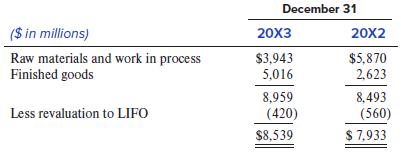Bourne Company (a fictional company) has the following inventory note in its 20X3 annual report. LIFO revaluations
Question:
Bourne Company (a fictional company) has the following inventory note in its 20X3 annual report.

LIFO revaluations decreased $140 million in 20X3, compared with decreases of $169 million in 20X2 and $82 million in 20X1. Included in these changes were decreases of $30 million, $12 million, and $3 million in 20X3, 20X2, and 20X1, respectively, that resulted from lower LIFO inventory levels. There were net cost decreases in each of the last three years. Bourne’s earnings before income taxes were $20.0 billion in 20X3. Assume a 21% marginal tax rate.
Required:
1. What are the total cumulative tax savings as of December 31, 20X3, that Bourne has realized as a result of using the LIFO inventory method?
2. What would Bourne’s pre-tax earnings have been in 20X3 if it had been using FIFO?
3. What December 31, 20X3, balance sheet amounts would be different—and by how much—if Bourne had used FIFO to account for its inventories?
4. What were the LIFO liquidation profits reported in 20X3 both pre-tax and after-tax?
5. Explain what factors cause the difference between the LIFO pre-tax income number and the FIFO pre-tax income number you estimated in requirement 2. (Hint: Reconcile the change in the LIFO reserve for 20X3.)
Step by Step Answer:

Financial Reporting And Analysis
ISBN: 9781260247848
8th Edition
Authors: Lawrence Revsine, Daniel Collins, Bruce Johnson, Fred Mittelstaedt, Leonard Soffer





